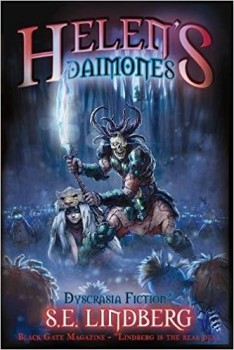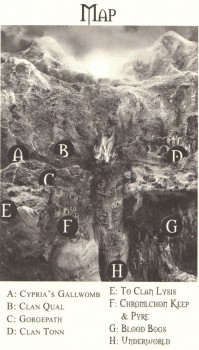Helen’s Daimones by S.E. Lindberg
 There are strange territories in the wilds of swords & sorcery that have been visited successfully by only a handful of writers. They are places where, aside from some actual swords and sorcery, few of the common trappings of the genre are found. Magic may be phatasmagorical, the world — both physically and culturally — has no echoes of our own, and the hero is more likely to be a golem, a resurrected nobleman, or a little girl than an axe-swinging warrior.
There are strange territories in the wilds of swords & sorcery that have been visited successfully by only a handful of writers. They are places where, aside from some actual swords and sorcery, few of the common trappings of the genre are found. Magic may be phatasmagorical, the world — both physically and culturally — has no echoes of our own, and the hero is more likely to be a golem, a resurrected nobleman, or a little girl than an axe-swinging warrior.
Some of C.L. Moore’s Jirel stories and most of Clark Ashton Smith’s oeuvre mapped portions of these realms. In Throne of Bones, Brian McNaughton (reviewed by me here) brought back a detailed study of one nation. Michael Shea and Darrell Schweitzer mapped whole continents. They’re dangerous places, permeated by darkness and decay, and the scent of death is rarely absent from the thick, curdled air.
S.E. Lindberg’s short novel, Helen’s Daimones (2017), is one such tale of this diseased stretch of the world of swords & sorcery. I can’t say this book quite attains the same heights as Shea’s Nifft the Lean or Schweitzer’s The Mask of the Sorcerer (reviewed here), but much of the time it comes tantalizingly close. It’s always exciting to find an author hunting out the stranger reaches of fantasy instead of re-exploring places we’ve all been many times before. This is the third published (second chronologically) novel in Lindberg’s Dyscrasia series. The word dyscrasia is from the Greek, and refers to a bad mixing of the four Classical humors: phlegm, blood, black bile, and yellow bile. In these books, there is no actual magic, only the disease Dyscrasia and corrupted souls.
Lindberg’s novel opens on his young protagonist, the daughter of a furrier, playing in the countryside.
Lithe, ivory-haired Helen crouched in the meadow. She spied the emerging fireflies, ready to play. A storm brewed on the distant, western horizon. Remote, thunderless lightning seemed to communicate to the fireflies with pulsing flashes. She wished she could interpret such magic.
“One day, I will understand your secret language,” Helen vowed.
She was accustomed to being apart from people, immersed in her own reality. Cloaked in a cougar pelt splotched with green dye, she was empowered by her feline familiar’s aura: Angie.
When Lord Donquason and his wife, Lady Nadeen, come to the furrier’s to discuss business, they bring their daughter, Sharon. She seems to be Helen’s one friend, and while the adults discuss dyeing and fur removal techniques, the girls go off to play. It is then that the storm Helen viewed earlier strikes. It is no ordinary one, bringing devastation and death. All three adults are killed, burned alive when the building they’re in is destroyed.
The girls, knocked out by the storm, wake to find a landscape where all the trees have been destroyed or burnt beyond recognition. A thick, ashy haze has settled on the land, blinding them to anything more than a few feet in front of them. Drawn by the glow of the burning buildings, Sharon understands their parents are dead, though Helen insists they might still be alive in the pile of blazing timbers. It’s here Lindberg begins to distinguish the two girls most clearly from each other. Sharon is more grounded in reality and Helen in her imagination.
When they hear someone approaching the ruins through the haze, even Sharon hopes for a moment it is her mother. It is not someone, though, but some thing. It is a wraith, seemingly called up in the wake of the storm, arrived in search of provender for its nest.
Both simultaneously dropped to their bellies. They watched in curiosity. The horror they observed was complex. Monstrous faces coalesced in the roiling vapors, yet it was a single wraith that shuffled forth on three human legs; a huge fourth hind leg was crippled, shaped like that of a cricket’s, and functioned only partially. It had three heads: a hairless human head lay limp on its right shoulder — its torso and legs merged with that of a giant bird; flanking the left, a tusked ant-head drooped lifeless; only the middle avian head appeared cognizant. A mixture of articulated long arms and shorter agile ones sprouted from the central abdomen. Many awkwardly-bent limbs shook with palsy. Three sets of wings emerged from a mass of exposed entrails, but it appeared too crippled to fly. Dozens of mutant appendages sprouted from the trailing posterior, all connected with glossy tissue, which wriggled like legs of a millipede.
The girls manage to elude the creature, and head off to the nearest town, hoping to find anyone who might help them. Before they can find sanctuary, they unknowingly investigate a house of horrors and get chased by a pair of monstrosities.
horrors and get chased by a pair of monstrosities.
During the girls’ travels, Helen’s Daimones’ other major characters are introduced. They are Lord Lysis and Doctor Grave, a skeletal warrior and a golem. For reasons far too complicated to go into here, the two are attempting to bring all the children of the land, the only humans capable of having survived the storm, together in Chromlechon Keep. It is Grave who finds and rescues Helen and Sharon, bringing them to safety. There begins a series of weirder, and weirder excursions into a land broken by disease and mutation.
And that’s where I’ll leave off regarding the novel’s plot. Trust me when I write that it’s madly complex and strange, weaving in and out of “reality” and “nightmare” from page to page, and sometimes from paragraph to paragraph. Lindberg doesn’t always do this deftly, so a few times I found myself lost and wondering what exactly was happening. I believe much of that, though, may be a result of my not having reading the previous books, Lords of Dyscrasia (2011) (reviewed here by Joe Bonadonna) and Spawn of Dyscrasia (2014). As much as I liked the characters of Lysis and Grave, the motives for their actions and interactions often eluded me. I guess what I need to do is go back and read Lords.
With that major caveat — perhaps one should have read Lords previously — I advise any lover of weird swords & sorcery to give Helen’s Daimones a read. First and foremost, Lindberg is a marvelous writer. You’ve already seen how well he conjures up long-legged beasts that go bump in the night, but he’s capable of some quite beautiful, evocative writing as well, as when he perfectly captures the imaginations of Helen and Sharon:
Playtime was at an end. In less than an hour’s span, the two enjoyed a lifetime of scenarios. They danced, chased bugs, had a tea party, and dreamt of their future.
The story, convoluted and complicated as it may get, moves with constant vigor. Helen is one of the stranger heroes to feature in swords & sorcery. Is she delusional, mad, gifted? I was never quite sure — she is only a little girl — but I was never able to take my eyes off her. With a cast as strange as this novel has, Helen remains the focus throughout. Even when she’s off stage, the question of what she is doing always seems to rise to the fore.
As I said in the beginning, Lindberg’s writing is not the equal of Michael Shea’s or Darrell Schweitzer’s. I don’t think he has quite as much control over this madness-drenched material as it requires all the time. Still, Helen’s Daimones is a fabulously original work that reaches into places too few authors attempt. Like the works of all the authors I named earlier, Lindberg’s book feels sui generis. There may be hints of Mervyn Peake and Clark Ashton Smith, but it’s not something simply cobbled together from bits of other writers’ works.
Too much of what’s called grimdark is little more than sex and gore splashed over a standard epic fantasy story. True horror — and at its heart, Helen’s Daimones is a horror story — unsettles, disorients, and makes you feel like the world will fall out from under your feet at any moment. Lindberg’s novel does all those things.
NOTE: S.E. Lindberg was interviewed by Joe Bonadonna earlier this year.
Fletcher Vredenburgh reviews here at Black Gate most Tuesday mornings and at his own site, Stuff I Like when his muse hits him. Right now, he’s writing about nothing in particular, but he might be writing about swords & sorcery again any day now.
Great review, Fletcher. I’m almost finished reading the book. Describing the plot is a tough one because of its layered complexity; hard to break down in a synopsis. You did a good job. Seth’s prose and pacing gets better all the time, and he had created something truly unique, and a grim world totally his own. Thank you and John O’Neal for the shout-out!
Wow. truly honored to have Fletcher review here on Blackgate… and so thorough too. A weird muse drives/haunts me, but it is challenging to make the weird-art accessible. Feedback like this will help readers consider the journey, but the review also helps me advance my craft. More of Helen’s development is in the works. Really appreciate this.
Great to see SE Lindberg’s work featured here. He’s one of the best writers out there. All we need now is Guillermo del Toro to do a film version of one of his books!
Lol. Wish I knew Guillermo personally! That would be a dream for most any writer.
[…] to admit that this novel subjected me to a certain amount of disorientation, but the reviewer at Black Gate had much the same impression. According to his Amazon profile, S.E. Lindberg was a professional chemist for two decades, and he […]